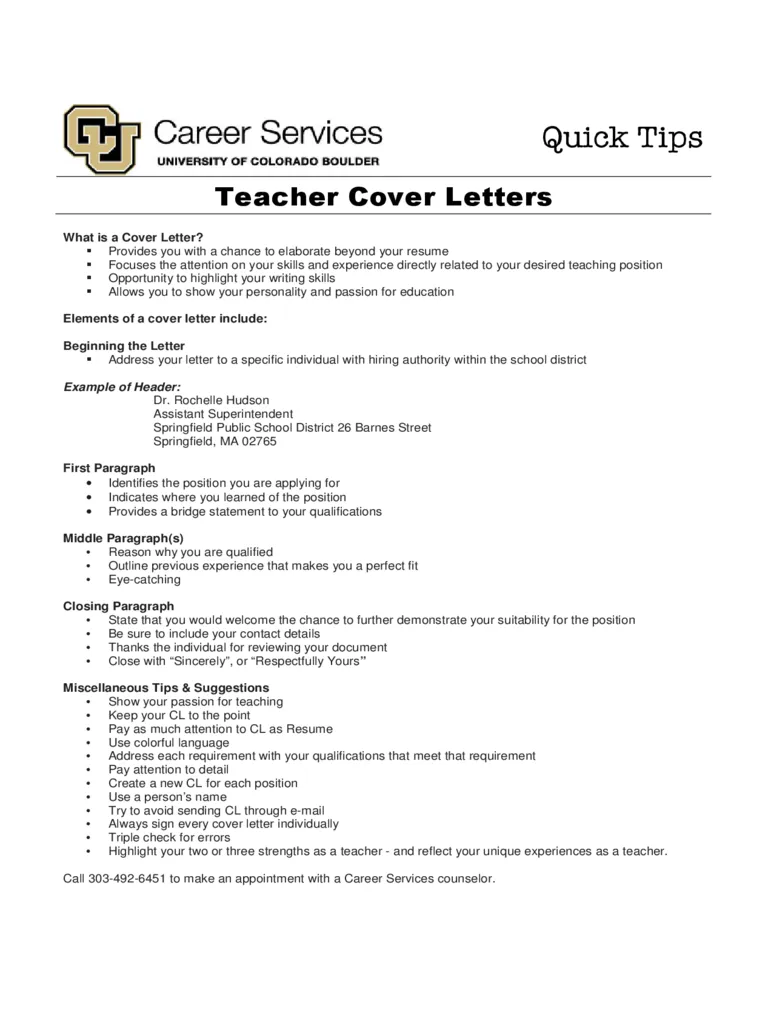Teacher Cover Letter Essentials
A well-crafted cover letter is your key to unlocking the door to your dream teaching position. It’s your opportunity to showcase your personality, passion, and qualifications in a way that your resume alone can’t achieve. A compelling cover letter should be more than just a summary of your resume; it’s a chance to tell a story, highlight your unique strengths, and demonstrate your genuine enthusiasm for the specific role and school. To write the best cover letter, the structure is very important. From the header to the final call to action, every element must be carefully considered. This guide will provide you with step-by-step instructions, insider tips, and practical examples to help you craft a cover letter that will captivate hiring managers and significantly increase your chances of landing an interview.
Contact Information and Date
The beginning of your cover letter sets the stage for the rest. Accuracy and professionalism are paramount. The header should include your full name, phone number, email address, and optionally, your LinkedIn profile URL. This section ensures the hiring manager has your essential contact details readily available. Following your contact information, you should include the date, which is the day you are submitting your application. It’s important to use the correct format (e.g., Month Day, Year) to demonstrate attention to detail. This structured approach immediately presents you as organized and professional, qualities highly valued in educators. The header helps with overall document organization and also helps the hiring manager quickly access your contact details.
Formatting the Header
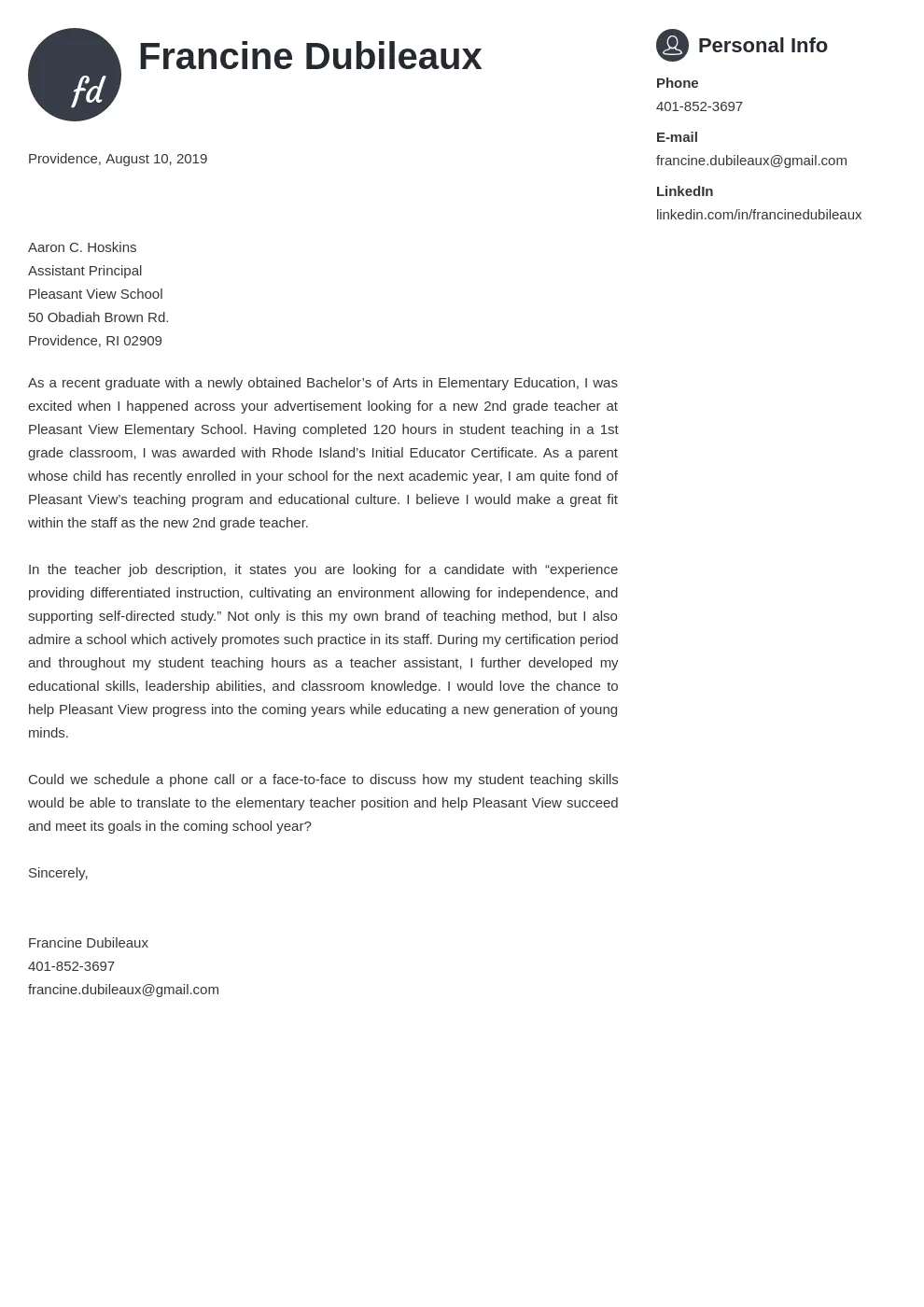
The header should be clean and easy to read. Use a clear, professional font. Avoid using any fancy designs or graphics in the header. The goal is to provide essential information in a simple, uncluttered way. Ensure that the font size is appropriate, typically between 10 and 12 points, to maintain readability. Your name should be prominent, often in a slightly larger font size. Your contact information should be concise and well-spaced. This sets a tone of professionalism right from the start, indicating that you are organized and detail-oriented.
The Date and Recipient Details
Below your header, include the date. Then, address the letter to the hiring manager by name. If possible, research the name of the person responsible for hiring. Addressing the letter to a specific person immediately makes it more personal and demonstrates that you have taken the time to research the school and position. If the name of the hiring manager is not available, you can use a general greeting like “Dear Hiring Committee.” Never use outdated greetings like “To Whom It May Concern,” which can make your letter seem impersonal and generic. Including the correct recipient details shows you care about the position.
Greeting the Hiring Manager
The salutation is your first direct communication with the hiring manager, so it should be professional and engaging. A strong opening sets a positive tone and encourages the reader to continue. This section is crucial for making a positive first impression. It’s your chance to immediately show that you’re attentive to detail and have a professional demeanor. A well-crafted salutation can capture the attention of the reader and make them interested in learning more about your qualifications. The greeting is a signal to the hiring manager that you are serious about the opportunity and that you have taken the time to research the school and the position. This initial courtesy can greatly increase your chances of making a favorable impression.
Using the Correct Salutation
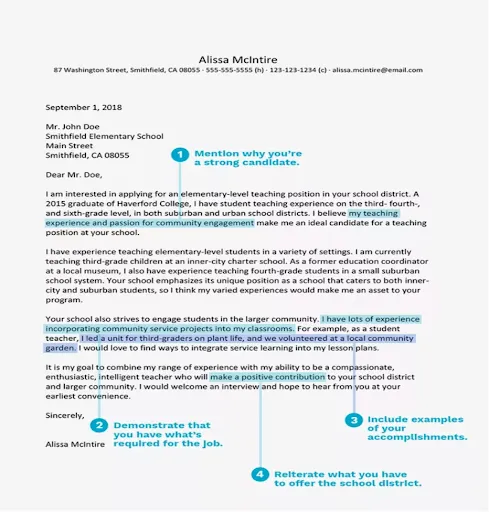
The standard greeting is “Dear Mr./Ms./Mx. [Last Name],” if you know the hiring manager’s name. Ensure you use the correct title and spelling. If you’re unsure of the gender or preferred title, using “Dear [First Name] [Last Name]” is a safe and professional approach. If a specific name is unavailable, use “Dear Hiring Committee” or “Dear [School Name] Hiring Team.” Avoid overly casual greetings like “Hi” or “Hello.” Maintain a formal yet approachable tone to project a professional image. The salutation should align with the overall tone of your cover letter, demonstrating your respect for the position and the school.
Body of the Cover Letter
The body of your cover letter is where you will present your case for why you are the ideal candidate. This section should consist of several well-structured paragraphs that effectively highlight your qualifications, experiences, and passion for teaching. Structure your body into logical paragraphs, each addressing a specific aspect of your suitability for the role. Use concise, clear language and avoid jargon. Each paragraph should have a clear purpose, such as introducing yourself, demonstrating your skills, providing specific examples, or summarizing your key qualifications. This section gives you an excellent opportunity to make a strong impression.
First Paragraph: Grabbing Attention
The first paragraph is your chance to capture the reader’s attention. Start with a strong opening sentence that clearly states your interest in the position and where you saw the advertisement. Mention the specific teaching position you are applying for and the school name. Then, briefly highlight your key qualifications or a particularly relevant experience. Demonstrate your enthusiasm by mentioning something specific that attracted you to the school. The goal is to immediately grab the reader’s interest and encourage them to continue reading. The first impression sets the tone for the rest of the letter, so make it count. This introductory paragraph must capture the reader’s attention immediately.
Highlighting Your Passion for Teaching
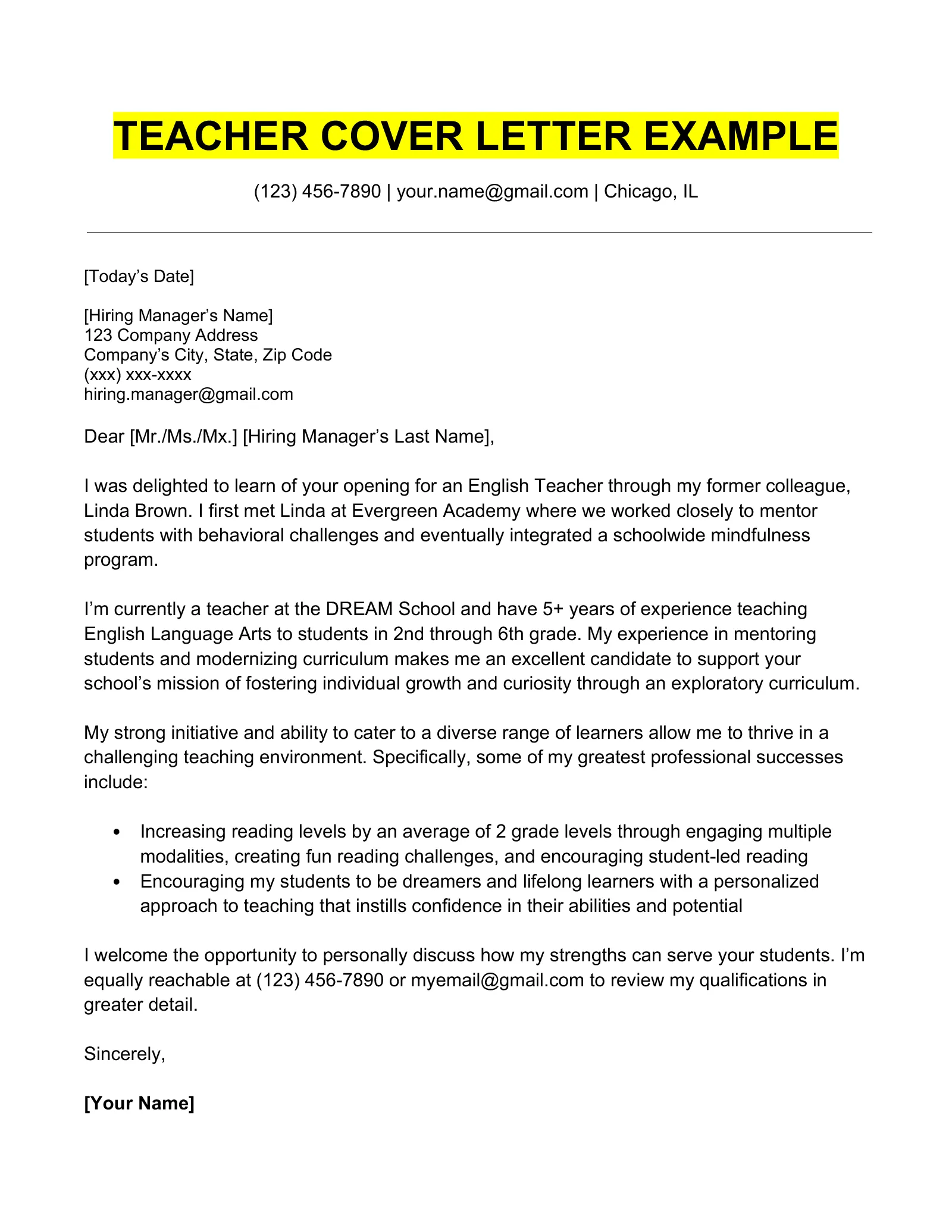
Clearly express your passion for teaching in the first paragraph. Share what specifically excites you about the role or school. Mention your educational philosophy or teaching style in a brief, engaging way. Demonstrate that you genuinely care about education and are committed to student success. Illustrate this passion with specific details. By showing genuine excitement and a clear teaching philosophy, you instantly stand out from other applicants. This immediately establishes you as someone who is enthusiastic and committed to making a difference. This is your chance to create a strong and memorable first impression. (Image: teacher-cover-letter-passion.webp)
Showcasing Your Key Skills
The middle paragraphs should showcase your key skills and experiences relevant to the teaching position. Identify the specific skills and experiences mentioned in the job description, and provide concrete examples. Use a balanced approach to demonstrate that you possess the required skills and experiences. Support your claims with evidence from your prior work. Focus on the aspects of your experience that align with the school’s mission and values. Highlight how your skills meet the school’s requirements and address their needs. This will help you stand out as a candidate who is a good fit for the role. Highlight these skills by providing specific examples. (Image: teacher-cover-letter-skills.webp)
Examples of Classroom Management
Provide examples that illustrate your skills in classroom management. Describe strategies you have used to create a positive learning environment. Give examples of how you handle student behavior, establish classroom routines, and foster a respectful atmosphere. Offer specific instances, such as implementing behavior management plans, using positive reinforcement, or resolving conflicts. The use of concrete examples adds credibility to your claims and demonstrates your ability to manage a classroom effectively. Consider describing how your classroom management approach aligns with the school’s policies. This helps to highlight your expertise and increase your chances of being hired.
Highlighting Relevant Experience
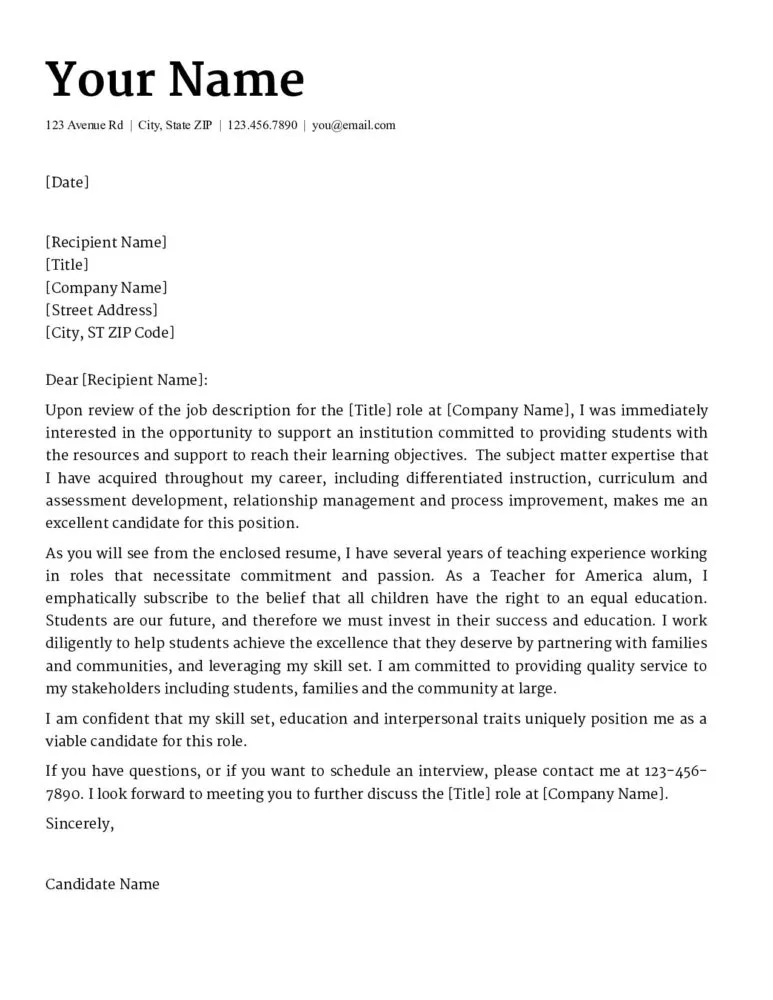
Give specific examples of your relevant experience. Summarize key responsibilities and accomplishments from past teaching positions. Provide specific details, such as the grade level taught, subjects, and any specialized programs you were involved in. Focus on experiences that closely align with the job requirements. Briefly describe your role, the students you taught, and the specific subjects you were responsible for. By providing detailed information about your background, you increase the likelihood of the hiring manager understanding and appreciating your experience. This helps establish you as a candidate who is prepared and has the necessary expertise to teach.
Demonstrating Your Achievements
Use this part of your cover letter to showcase your achievements. Rather than just listing responsibilities, highlight specific accomplishments. Provide quantifiable results whenever possible. Use data to support your claims. This demonstrates the impact of your work and showcases your success as a teacher. Demonstrate the results of your work to the hiring manager. This is the chance to display your achievements and highlight the positive impact you have on students and the educational environment. By providing specific examples and measurable results, you can make a strong case for why you are the best fit for the position.
Quantifying Your Impact
Use numbers and data to showcase the impact you have made. Quantify your achievements whenever possible. Instead of saying, “Improved student test scores,” state, “Increased student test scores by 15% through the implementation of…” Provide specific examples and quantifiable results. This approach makes your achievements more convincing. Quantify your impact by sharing measurable results. This will demonstrate to the hiring manager the positive contributions you can bring to their school. Using concrete metrics makes your achievements more convincing and shows that you have a track record of success. By quantifying your achievements, you demonstrate your success as a teacher.
Closing the Cover Letter
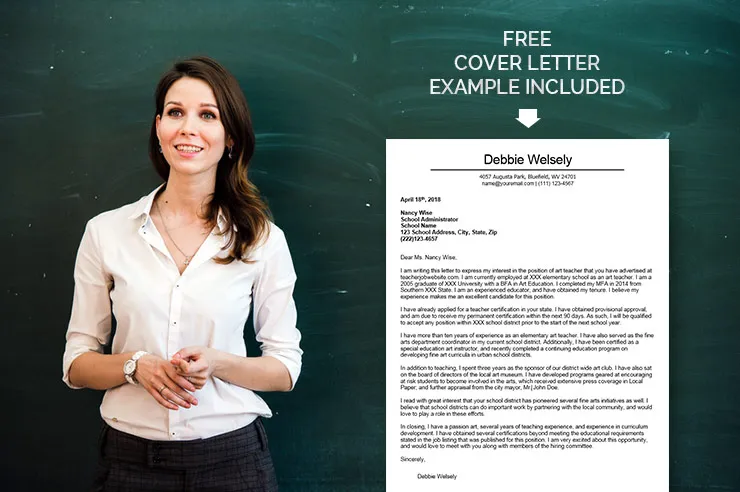
The closing is an opportunity to express your enthusiasm and provide a call to action. It should be professional and leave a positive final impression. The goal is to clearly summarize your interest in the role and express your desire for an interview. In the closing, you reiterate your interest and invite the hiring manager to contact you. It also demonstrates your professionalism and eagerness. A well-crafted closing ensures that the hiring manager remembers you favorably and is motivated to reach out.
Expressing Gratitude and Enthusiasm
Express your gratitude for the opportunity to apply and for the hiring manager’s time and consideration. Reiterate your enthusiasm for the position and the school. Make sure to end with a positive and forward-looking statement. Thank the hiring manager for their time, and restate your enthusiasm for the position. Express your sincere interest in the opportunity. The closing should reflect your appreciation and emphasize your strong desire to work at the school. (Image: teacher-cover-letter-closing.webp)
Call to Action
Include a clear call to action, inviting the hiring manager to contact you. Provide your contact information again, making it easy for them to reach you. Express your availability for an interview. A simple statement like, “I am eager to discuss my qualifications further and am available for an interview at your earliest convenience,” is effective. By providing your contact information and making yourself available for an interview, you make it as easy as possible for the hiring manager to move forward. This increases the chances of you being selected for an interview. Providing a clear call to action shows that you are proactive and interested in the role.
Formatting and Proofreading
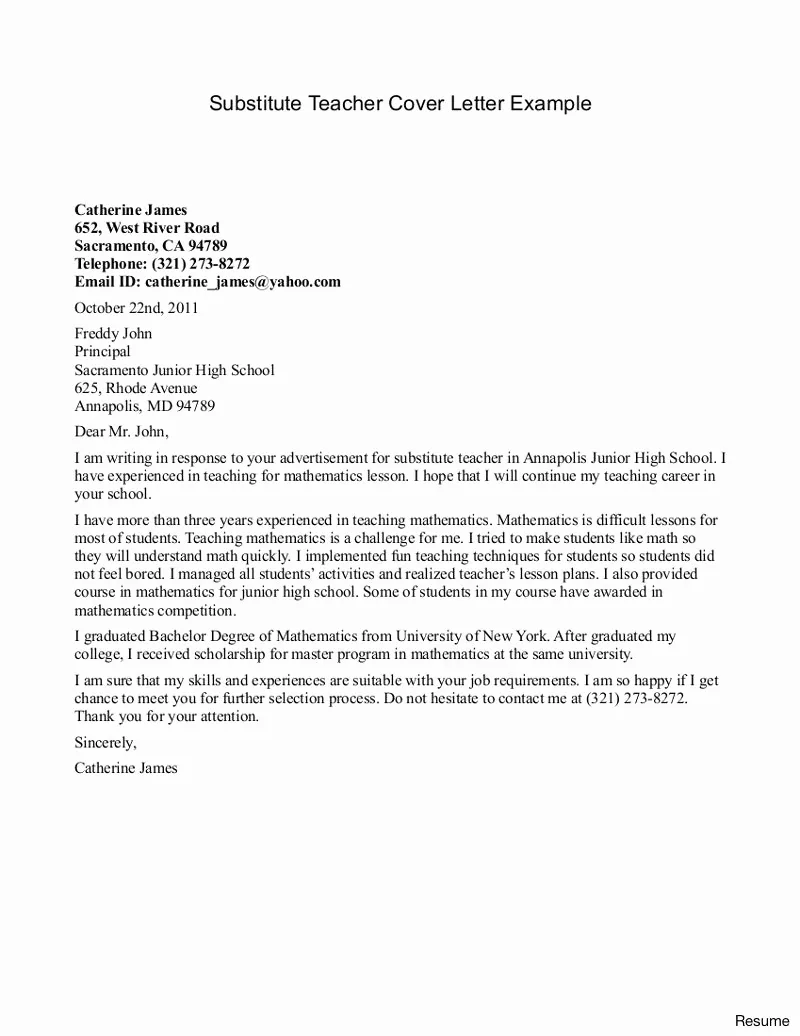
The appearance of your cover letter is as important as its content. A professional, well-formatted letter indicates attention to detail and respect for the hiring process. The formatting is an important factor. Proofreading is critical. Before submitting your cover letter, ensure it is formatted correctly and free from errors. It shows that you care about the details and are committed to creating a polished application. Make sure your cover letter is easy to read and accurately reflects the professionalism that schools expect. These steps show that you are detail-oriented and value creating a professional presentation. (Image: teacher-cover-letter-font.webp)
Choosing the Right Font and Size
Choose a professional, easy-to-read font, such as Times New Roman, Arial, or Calibri. Use a font size between 10 and 12 points. Ensure that your text is evenly spaced and has appropriate margins. A font that is easy to read allows the hiring manager to concentrate on the content rather than the formatting. The correct font and font size makes it easier for the hiring manager to read your letter. Well-chosen fonts and sizes also enhance readability. Use a font size between 10 and 12 points for the main text. Maintain appropriate margins to ensure the letter looks clean and organized. These design elements significantly improve the appearance of your cover letter and make it easier to read. (Image: teacher-cover-letter-font.webp)
Proofreading for Errors
Proofread your cover letter carefully. Check for any typos, grammatical errors, or spelling mistakes. Read the letter aloud to catch any awkward phrasing or sentence structure. Ask a friend or colleague to proofread it for you, as a fresh pair of eyes can often spot mistakes you might miss. Errors can undermine your credibility and signal a lack of attention to detail. The best way to avoid errors is to proofread carefully. This meticulous approach will guarantee a professional and polished cover letter that can make a great first impression.
Finalizing and Submitting
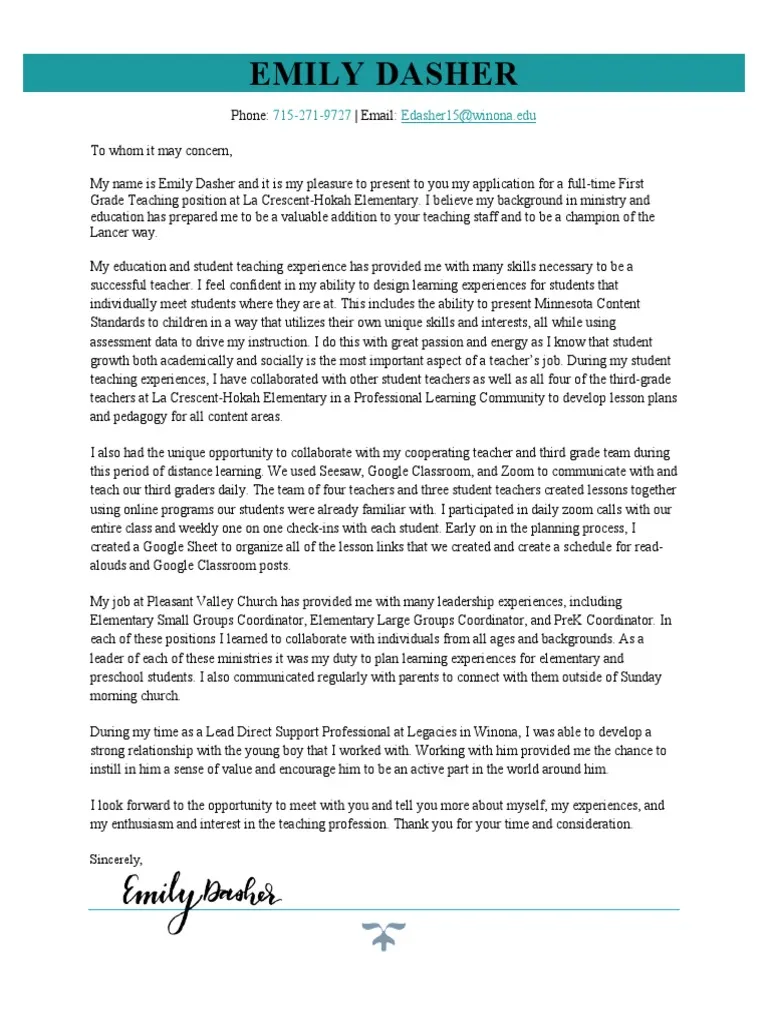
Before submitting, review your cover letter one final time. Ensure all details are accurate, including the name of the hiring manager and the school. Confirm that the letter is in the correct format and free from any errors. Save your cover letter as a PDF to maintain formatting consistency. When submitting your application, follow all instructions. If you send it as an attachment, use a professional file name. Make sure your cover letter is tailored for the job to show your attention to detail and increase your chances of being invited to an interview. By taking these steps, you will ensure your cover letter is polished and ready for submission. (Image: teacher-cover-letter-submit.webp)
